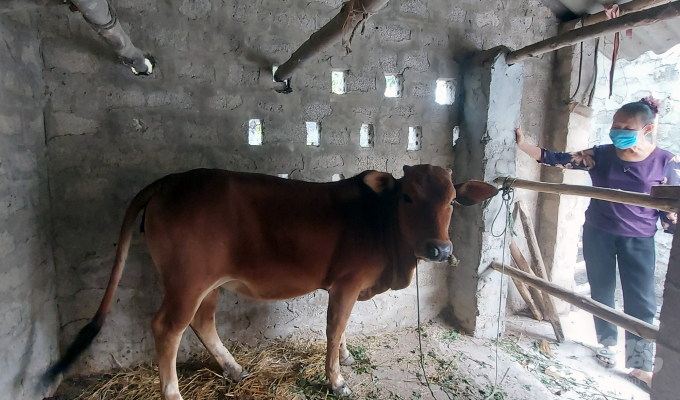November 24, 2025 | 02:04 GMT +7
November 24, 2025 | 02:04 GMT +7
Hotline: 0913.378.918
November 24, 2025 | 02:04 GMT +7
Hotline: 0913.378.918
The move came after the report of the Ministry of Agriculture and Rural Development showed that the first time that Lumpy skin disease on cows and buffaloes appeared in Viet Nam was October 2020.
As of May 10, there have been 1,660 outbreaks reportedly occurred in 1,622 communes of 29 provinces and cities nation-wide.
It has caused a total of 44,700 cows and buffaloes contracting the disease and killed over 5,100 others.
It is forecasted that in the coming time, Lumpy skin disease will continue to spread on a large scale, especially when weather conditions have changed and the season that flies, mosquitoes grow is coming.
Therefore, to minimise damage to farmers, Chinh required head of People’s Committee of cities and provinces to take cohesive measures to prevent Lumpy skin disease on cows and buffaloes in accordance with the provisions of the law on veterinary medicine and the guidance of the ministry.
The head of the People’s Committee of provinces and cities also had to take full responsibility for the prevention and control of Lumpy skin disease in the localities, he said.
The disease-hit localities were told to declare the disease according to regulations; concentrate resources and synchronously apply solutions to control and definitively handle outbreaks under regulations, preventing the disease from spreading for a long time, he said.

A female cow, suffering from Lumpy skin disease, has been treated and recovered gradually in Nghi Son Town, Thanh Hoa Province. Photo: Vo Dung.
The localities were ordered to vaccinate cows and buffaloes, supervise, early detect and timely handle new-arising outbreaks to prevent the disease from spreading, he added.
They also had to instruct buffalo-and-cow breeders to increase the application of proactive measures to prevent the disease, he said.
Besides, authorised agencies were tasked to spray disinfectants to prevent flies, mosquitoes and gnats that could transmit the disease to cows and buffaloes in the localities, he said.
The localities were also required to make detailed plans and allocated funds to prevent and control the disease as regulations, he said.
Other tasks included supervising closely the gathering and trading of cows and buffaloes as well as products from cows and buffaloes; strengthening inspection of hygiene and food safety especially in slaughterhouse and facilities of processing products of cows and buffaloes; as well as disseminating local people to actively take measures to prevent and control the disease, he said.
Chinh also assigned the agricultural ministry to work with relevant agencies to allocate funds to actively monitor the disease situation, ensure early detection, warn and thoroughly handle the outbreak.
The ministry had to direct and instruct the import of vaccines to prevent the disease as well as urgently finish the testing and approval of vaccine circulation following regulations, he said.
The ministry was told to work with the Ministry of Science and Technology and relevant units to research on the epidemiology of the Lumpy skin disease and measures to effectively prevent the disease.
The ministry was also tasked to conduct research to produce domestic vaccines to prevent the disease, he added.
Additionally, the ministry should coordinate with the Ministry of Finance to issue mechanisms to support breeders and localities in preventing and controlling the disease as regulations.
It was required to actively coordinate with international organisations and foreign countries in sharing and supporting Viet Nam in the prevention and control of the disease.
The Ministry of Information and Communications was told to direct central and local press agencies to promptly provide information on the disease situation and promote dissemination on measures to prevent and control the disease to breeders so that they did not panic and actively apply measures to prevent the disease under the guidance of specialised agencies.
Chinh also ordered the National Steering Committee 389 to direct the coordination between agencies and functional forces to promptly prevent smuggling and illegal transportation of buffaloes and cows and products from buffaloes and cows from foreign countries to Viet Nam.
Lumpy skin disease (LSD) is a devastating disease of cattle and buffalo caused by a capripox virus. It is believed that arthropod vectors, direct contact, contaminated feed and water and iatrogenic means (for example, repeated use of needles on different animals) can all spread the disease.
The virus is present in high concentrations in the skin nodules and scabs on affected animals and can be isolated from blood, saliva, ocular and nasal discharges and semen.
Lumpy skin disease virus can be found in blood for up to 21 days post-infection but shedding in semen may continue for at least 42 days post-infection.
Translated by Thu Hang

(VAN) The agricultural sector is finalizing the strategic framework for emission reduction, setting the goal of sharply cutting methane and 403.7 million tons of CO2 equivalent and moving toward Net Zero by 2050.
/2025/11/22/2236-1-153832_483.jpg)
(VAN) The National Marine Spatial Planning is opening up opportunities for sustainable blue sea development across 21 coastal localities.

(VAN) Viet Nam’s forestry sector is undergoing a comprehensive transformation, strengthening management, protection, and development efforts to maintain ecological security and drive green, sustainable growth.

(VAN) Viet Nam is accelerating efforts to digitize reservoir operations, from real-time data to hydraulic modelling.
/2025/11/21/3348-2-102623_454.jpg)
(VAN) National Assembly delegate Nguyen Thi Lan has proposed adding special mechanisms to attract human resources to the agricultural, forestry, and fishery sectors, addressing the shortage of high-quality personnel.

(VAN) Over the past two decades, the unified legal framework for water resource management has been perfected, becoming a crucial foundation for ensuring national water security.

(VAN) The land-data cleansing campaign in Dien Bien is entering its final stretch, yet weak infrastructure, limited personnel and fragmented multi-period datasets continue to create major obstacles.